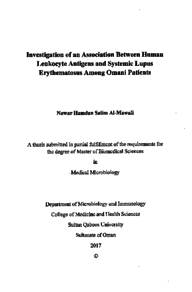Document
Potential involvement of human leukocyte antigen-DR/DQ polymorphisms with schizophrenia among patients with schizophrenia in Yemen.
Identifier
DOI 10.5001/omj.2024.46
Source
Oman Medical Journal, v. 39, no. 1, e635 p. [1-6].
Contributors
Hassan, Sami Mohammed Abdo., Author
Country
Oman
City
Muscat
Publisher
Oman Medical Specialty Board.
Gregorian
2024-01-01
Language
English
English abstract
To evaluate the hypothesis that human leukocyte antigens (HLAs) confer
susceptibility to schizophrenic disorders, by assessing their contribution to the risk of
schizophrenia in a Yemeni population. Methods: The researchers approached patients
who had been diagnosed with schizophrenia at Al-Amal Hospital for Psychiatric Diseases,
Sana’a. Controls were drawn randomly from the general population. The HLA class II
alleles of the participants were examined. The genotypes of the HLA-DQB1 and HLADRB1 alleles were determined by polymerase chain reaction using sequence-specific
primers. Results: The subjects comprised 110 patients with schizophrenia, matched
by an equal number of controls. The prevalence of HLA-DRB1*04 was significantly
higher among patients than among controls (7.3% vs. 0.0%; p = 0.003), as was HLADRB1*07 (62.7% vs. 17.3%, odds ratio (OR) = 8.1, 95% CI: 4.3–15.1; p 0.001). HLADRBI*14 was significantly less prevalent among patients (0.9% vs. 11.8%, OR = 0.06,
95% CI: 0.01–0.50, χ2
= 10.9; p 0.001). HLA-DQB1*07 was the most common allele
discovered in schizophrenia patients and was found to have a much higher incidence
in patients than the control group (22.7% vs. 4.5%, OR = 6.2, 95%CI: 2.3–16.8, χ2
=
15.4; p 0.001). Conclusions: The HLA-DQB1 and HLA-DRB1 gene loci are linked
to schizophrenia in the Yemeni population, according to the current study’s evidence.
ISSN
1999-768X (Print)
2070-5204 (Electronic)
Category
Journal articles


